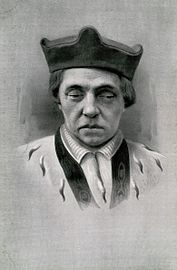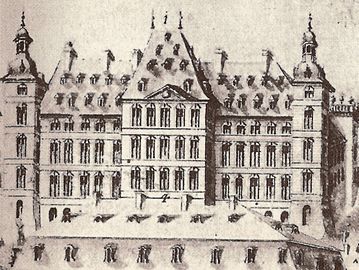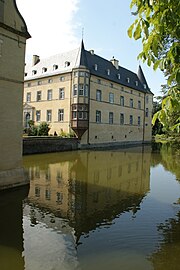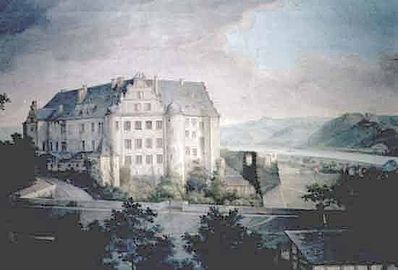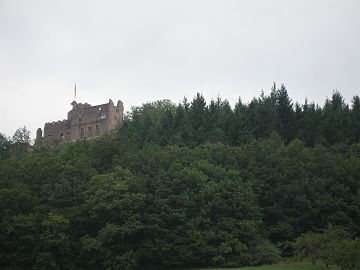Leyen (noble family)

The house von der Leyen is one of the Mosel -derived sex of the aristocracy . Ancestral castle is the upper castle in Gondorf (also called Schloss (von der) Leyen ), the only moated castle on the Moselle. The Leyen were inherited from the Electorate of Trier. The sex died out in 1971 with Ferdinand Maria Prinz von der Leyen in the male line. The house still exists as a result of adoption: Prince Erwein III adopted his daughter's son in 1969.
Origin and career
Herren von der Leyen
The Gender von der Leyen comes from the Burg Leyen (also Obernburg called) on the Moselle and was called to 1500 also de Guntravia ( "from Gondorf") or de Petra . The Leyen Castle was probably built in the 12th century, but was only mentioned in a document in 1272: They sat "in the Huse zu der Leyen uf der Musele". The von der Leyen were initially servants or ministers of the Archbishops of Trier , all of whom appear in the Rhine-Mosel-Saar triangle. In 1320, Siebrecht von der Leyen zu Gondorf became the fief of Count Wilhelm I von Katzenelnbogen . He receives u. a. a vineyard as a fief. In 1448 Johann von der Leyen is mentioned in the family castle of the Counts of Katzenelnbogen. After the castle died out and the castle was completely destroyed by fire, the von der Leyen family rebuilt today's Katzenelnbogen Castle , called Von der Leyen'sches Haus , in 1584.
By marriage in 1456 of Georg I. von der Leyen (1434-1509), son of Johann von der Leyen († around 1455) and Kunigunde von Eltz († 1460), with Eva von Mauchenheim zu Zweibrücken († 1512), from a family of simple castle men of the Counts of Zweibrücken , the von der Leyen family got an additional pillar in Bliesgau (in today's Saarland), where in 1486 they inherited part of Blieskastel Castle, among other things . The couple had sons Simon von der Leyen (1471-1512), from May 31, 1491 to April 8, 1512 the 22nd abbot (under the name Simon de Petra) in Maria Laach , Werner von der Leyen († 23 March 1512), Bartholomäus I. von der Leyen († 1540), councilor and bailiff (1529–1540) in Andernach , and Johann I. von der Leyen. In 1512 Eva, the wife of Georg I von der Leyen, and two of his sons died. Also through the connection with the Mauchenheimers, the von der Leyen inherited in 1481 the initially much closer rule of Saffig , a fiefdom of the Electorate of Cologne. (In Saffig a separate line of those von der Leyen emerged, which went out in 1703 with the baron Karl Kaspar von der Leyen. The Electorate of Cologne then fell to the older line of the Counts von der Leyen.) Georg I. von der Leyen built through in 1479 the additional purchase of the Dadenberger Hof from the knights of Dattenberg near Linz made the minor property in Nickenich, which had been inherited in 1444, decisive. In 1520 Bartholomäus I von der Leyen acquired Adendorf Castle , and in 1525 the nearby Münchhausen Castle and sheep farm.
Johann VI. von der Leyen , Elector Archbishop of Trier (1556–1567)
In 1512 the abbot Simon von der Leyen (son of Georg I. von der Leyen), 22nd abbot of Laach Abbey , was allegedly murdered by a witch using poisoned cheese.
The family's reputation continued to grow when Johann II von der Leyen (1510–1567), the youngest son of Bartholomäus I von der Leyen from the von der Leyen-Saffig line and his wife Katharina von Palandt , became Johann VI in 1556 . von der Leyen was elected Elector and Archbishop of Trier (1556–1567).
At the end of the 16th century, two secondary lines split off from the main line, where the most important Saffig property at the time remained: von der Leyen zu Wachtberg - Adendorf and von der Leyen zu Nickenich on the Pellenz (the village of Nickenich was close to the Maria Laach Abbey). The grandson of Bartholomew I von der Leyen, Georg III. von der Leyen, like him and his father Georg II. von der Leyen (council from 1540– ~ 1584) was electoral Cologne councilor and bailiff in Andernach (~ 1584–1612) and built the “von der Leyensche Haus”, today the city museum , in the Year 1600.
Barons von der Leyen
The second elector of Trier from the family of the von der Leyen (from the branch line to Adendorf), Karl Kaspar von der Leyen (1652–1676), promoted the members of his family and the property of his family, which was founded in 1653 by Emperor Ferdinand III . was raised to the imperial baron status. In 1654 he made his younger brother Damian Hartard von der Leyen , later Elector of Mainz (1675–1678), provost and archdeacon of Karden within the Archdiocese of Trier. In 1660 he enfeoffed his other brother Hugo Ernst von der Leyen with the Electorate of Trier Blieskastel. The family thus had its own rule with judicial and taxation rights.
The influential brothers, who were rich through the possibilities of their offices, purposefully bought up a closed territory around Blieskastel: 1655 Ommersheim , Heckendalheim and the Webenheim dairy , 1656 the rule Medelsheim , 1657–1664 Wölferdingen and the Helmstatt half of St. Ingbert , 1659 the castle Wecklingen , 1667 the rule Forbach and 1670 Gersheim .
On 15 September 1653 the Trier Elector Karl Kaspar von der Leyen pledged his cousin Lothar Ferdinand von der Leyen the spots Nickenich for 2,000 dollars. Only in 1728 was the pledge redeemed by Kurtrier. Archbishop Karl Kaspar von der Leyen enfeoffed the son of his brother Hugo Ernst von der Leyen († 1665), Karl Kaspar von der Leyen (* 1655, † 1739), with the Electorate of Trier Arenfels , to which u. a. Hönningen belonged. He appointed his other nephew Johann Hugo von Orsbeck as his own successor as Elector of Trier . Archbishop Karl Kaspar von der Leyen ended the witch hunt within the Archdiocese of Trier by secret order.
Damian Hartard von der Leyen bought the Electorate of Neuerburg with Waldbreitbach an der Wied (not for the Archdiocese of Mainz, but for the von der Leyen) as a pledge in 1678, which was redeemed by Kurköln in 1740 .
Karl Kaspar von der Leyen , Elector Archbishop of Trier (1652–1676)
Damian Hartard von der Leyen , Elector Archbishop of Mainz (1675–1678)
Arenfels Castle around 1670
Hohengeroldseck castle ruins
Count von der Leyen
Karl Kaspar von der Leyen (* 1655, † 1739) was enfeoffed in 1693 by Emperor Leopold I with the Habsburg rule Hohengeroldseck in the Ortenau , which he enjoyed in 1697. In 1711 he was raised to the rank of imperial count. The Hohengeroldseck Castle had already been destroyed by French troops in 1689, so the administration of the rule was established at the nearby Dautenstein Castle .
The main residence of the Counts von der Leyen was initially in Koblenz in Von der Leyen'schen Hof (Kastorhof 2), a three- story baroque hipped roof building from 1725 with a late Gothic chapel. In 1773 the residence was moved to Blieskastel Castle , which, however, was looted and destroyed in the unrest after the French Revolution in 1793/94.
Prince von der Leyen
With the small rule of Hohengeroldseck, Count Philipp Franz von der Leyen, as a party member of Napoleon, became a founding member of the Rhine Confederation on July 12, 1806 and was also given the title of Prince von der Leyen . With Napoleon's fall in 1815, Philipp Franz lost his principality. The mediatized family kept the title of prince. In 1820, Hereditary Prince Erwein von der Leyen acquired the Waal castle and estate as the family's new residence. Adendorf Castle was sold in 1829, the summer residence Arenfels Castle in 1848, as well as Saffig Castle . Castle and Gut Waal - as well as Hohengeroldseck - are still owned by the descendants today.
Karl Theodor von Dalberg , Prince Primate of the Rhine Confederation, was the brother of Countess Marianne von der Leyen and Prince Philipp Franz von der Leyen's uncle .
coat of arms
The family coat of arms shows a silver pole in blue . On the helmet with blue-silver helmet covers a silver male head between an open flight , whose wings are each sprinkled with seven silver linden leaves .
Until the end of the 16th century, the soaring winged male did not wear a collar. This did not appear until the 18th century, mostly in red, rarely also in gold, and very occasionally in black. Two winged greyhounds with blue collars are used as shield holders.
List of Lords of Blieskastel
In 1660 Hugo Ernst von der Leyen was enfeoffed with the Electorate of Trier Blieskastel. Below is a list of the gentlemen von Blieskastel from the von der Leyen - Adendorf line:
| Reign | Surname | Remarks |
|---|---|---|
| 1657-1665 | Imperial Baron Hugo Ernst von der Leyen |
Hugo Ernst is a son of the Trier court master Damian von der Leyen zu Adendorf (* 1583; † 1639) and Anna Katharina Waldbott von Bassenheim (* 1587; † 1666). He is the brother of the Electors Karl Kaspar von Trier (* 1618; † 1676) and Damian Hartard of Mainz (* 1624; † 1678). Hugo Ernst has been married to Sophia Maria Quadt von Buschfeld since 1652 . |
| 1665-1687 | Reich Baron Damian Adolf von der Leyen |
Damian Adolf is a son of Baron Hugo Ernst von der Leyen. He is married to Amalia Anna Franziska Reichsfreiin Raitz von Frentz († 1687). Since the marriage remained childless, his brother Karl Caspar von der Leyen succeeded him in the Blieskastel reign in 1687. |
| 1687-1733 | Baron Karl Kaspar von der Leyen (* 1655; † 1739) |
Karl Caspar is a son of Baron Hugo Ernst von der Leyen. Since 1711 Reich Count von Hohengeroldseck (in the northern Black Forest) with seat in the Reichstag. Karl Caspar has been married to Maria Sophie Reichsfreiin von Schönborn (* 1670; † 1742) since 1687 . Her father Melchior Friedrich has been an imperial count since 1701. |
| 1733-1760 | Imperial Count Friedrich Ferdinand Franz von der Leyen (* 1709; † 1760) |
He is a son of Count Karl Casper von der Leyen. Before Count Friedrich Ferdinand was able to rule the Leyensche inheritance in Koblenz since 1739, he already resided in Blieskastel from 1733 to 1739. In 1739 he succeeded his father in the government of all territories of the Imperial Count von der Leyen. Friedrich Ferdinand Franz has been married to Countess Maria Charlotte Auguste von Hatzfeld since 1733 . |
| 1760-1775 | Imperial Count Franz Karl von der Leyen (* 1736; † 1775) |
He is a son of Count Friedrich Ferdinand Franz. Count Franz Karl has two brothers: Damian Friedrich and Franz Erwein, Counts von der Leyen. In 1773 the imperial count couple Franz Karl and Marianne von der Leyen, b. from Dalberg , the residence from Koblenz to Blieskastel. |
| 1775-1791 | Countess Marianne von der Leyen (* 1745; † 1804) |
She has been the wife of Count Franz Karl von der Leyen (* 1736; † 1775) since 1765, as a widow regent in Blieskastel for her underage son Count Philipp Franz (* 1766; † 1829). |
| 1791-1793 | Imperial Count Philipp Franz von der Leyen (* 1766; † 1829) |
In fact, he is still represented in Blieskastel by his mother, Countess Marianne , who, however, fled from the French in 1793. |
Territorial possession of the Imperial Count von der Leyen
The following list shows the territorial holdings of the Imperial Counts von der Leyen for the status of the year 1793:

- Territories to the left of the Rhine
On the eve of the conquests by revolutionary France , the territorial holdings of the Imperial Count von der Leyen on the left of the Rhine amounted to 66 very scattered villages with a total of almost 19,000 inhabitants. The related areas in detail were:
- Immediate imperial rule Blieskastel with St. Ingbert , 38 places, 11,104 inhabitants
- Immediate imperial rule Münchweiler am Glan , 7 towns, 1,461 inhabitants
- Immediate imperial rule Otterbach and Sambach , 2 places, 395 inhabitants
- Immediate imperial rule of Burrweiler and Wernersberg , 4 places, 1827 inhabitants
- Immediate imperial rule Oberkirchen near St. Wendel , 5 villages, 746 inhabitants
- Immediate imperial rule of Leiningen in the Hunsrück , 4 towns, 1204 inhabitants
- Immediate imperial rule Adendorf near Bonn, 3 places, 1361 inhabitants
- Dominion Saffig with Kalenborn and Eppenberg, 3 places, 607 inhabitants
- Territories to the right of the Rhine
- Rule of Nievern on the Lahn. In 1629 the Counts von der Leyen acquired the parish and lost it to Nassau in 1804 .
- Jurisdiction Geroldseck near Lahr in the Black Forest with the main town of Seelbach . This rule was the remainder of the territorial possessions that the imperial count Philipp von der Leyen , who was reigned by Emperor Napoleon, still had when he joined the Confederation of the Rhine in 1806 with this principality from der Leyen . In 1815 this territorial property was initially lost to the Austrian Empire at the Congress of Vienna and then finally fell to the Grand Duchy of Baden in 1819 . As a noble family, the head of the family was a member of the First Chamber of the Baden Estates Assembly .
List of the princes von der Leyen
The following list of the Prince von der Leyen and the bosses of the house since 1918 follows the information provided by E. Klitscher:
| Duration of the title | Surname | Remarks |
|---|---|---|
| 1806-1815 / 1829 | Prince Philipp Franz Wilhelm Ignaz von der Leyen (* 1766; † 1829) |
1801: by Duke Friedrich August von Nassau enfeoffed with Arenfels Castle 1806: Elevation to Prince von der Leyen at the instigation of his uncle Karl Theodor von Dalberg 1815: With the conclusion of the Congress of Vienna , the Principality of von der Leyen is mediatized . Philipp was married to Sophia Theresia Walpurgis Countess von Schönborn- Buchheim (* 1772 |
| 1829-1879 | Prince Karl Eugen Damian Erwein I . von der Leyen (* 1798; † 1879) |
2. Prince von der Leyen and Count von Hohengeroldseck Acquires the manor Waal- Unterdiessen in Swabia. |
| 1879-1882 | Prince Philipp Franz Erwein Theodor von der Leyen (* 1819; † 1882) |
3. Prince von der Leyen Married to Adelheid Caroline Princess von Thurn und Taxis (* 1829, † 1888) |
| 1882-1920 | Prince Erwein II. Theodor Philipp von der Leyen (* 1863; † 1938) |
4. Prince von der Leyen (until 1920) Married to Marie Charlotte Princess zu Salm-Reifferscheidt (* 1867, † 1944) |
List of the bosses of the von der Leyen house
| Duration of the title | Surname | Remarks |
|---|---|---|
| 1920-1938 |
Erwein Theodor Philipp Fürst von der Leyen (* 1863; † 1938) |
For his time as a registrar in the Kingdom of Bavaria, see above |
| 1938-1970 | Erwein Otto Philipp "Prince" von der Leyen (* 1894, † 1970) |
Married to Donna Maria Nives Ruffo |
| 1970– | Philipp Erwein Prince von der Leyen u. zu Hohengeroldseck (* 1967) | (Son of Georg Freiherr von Freyberg zu Eisenberg and Marie Adelheid Princess von der Leyen u. Zu Hohengeroldseck. As a result of the adoption in 1969 by his grandfather Erwein Otto Philipp, he continues the family name. Owner of the castles Waal and Hohengeroldseck.)
Married to Elisabeth Freiin von Gagern |
Other noble families of von der Leyen
In the area around the Moselle there were several noble families who call themselves "von Leyen" or "von der Leyen", but all differ in their coat of arms ( von der Leyen from Ürzig , von Leyen from Ockenfels , von Leyen from Burg Layen in Rümmelsheim ). Furthermore, the Krefeld silk industrial family von der Leyen , ennobled in 1786 , to which the line of the barons von der Leyen zu Bloemersheim also belongs.
literature
- Wolfgang Krämer: 800 years of the von der Leyen family , self-published, Gauting near Munich 1958, also Saarbrücker Zeitung from August 13th to 19th, 1958.
- Wolfgang Krämer: Contributions to the family history of the mediatized house von der Leyen and Hohengeroldseck in the 16th century , Gauting 1964.
- Genealogical manual of the nobility , Fürstl. Houses Volume X, Limburg ad Lahn 1978.
- The landlords in Bavarian Swabia , in: Augsburg contributions to the regional history of Bavarian Swabia II , edited by P. Fried, 1982, p. 154 f.
- The Counts von der Leyen and the Blieskastel Office , exhibition catalog, Blieskastel 1991.
- Anja Ostrowitzki (edit.): Inventory of the files and official books of the archives of the princes von der Leyen in the state main archives Koblenz. Koblenz 2004 (publications by the Rhineland-Palatinate State Archives Administration, Volume 102).
- Anja Ostrowitzki (arr.): Inventory of the medieval documents of the archives of the princes von der Leyen in the state main archives Koblenz. Koblenz 2010 (Publications of the Rhineland-Palatinate State Archives Administration, Volume 112).
- Joachim P. Heinz: The Reichsdeputationshauptschluss (1803) and the dissolution of the Palatinate counties Wartenberg, Sickingen and von der Leyen . In: Mitteilungen des Historisches Verein der Pfalz , 111th Bd., 2013, pp. 185–265. [not evaluated]
Web links
- Family von der Leyen and zu Hohengeroldseck in Gotha
- Grave monuments of the Leyen family
- The division of the noble family into three lines
Individual evidence
- ^ Martina Holdorf: Castles and palaces on the Middle Rhine . Görres, Koblenz 1999, ISBN 3-920388-71-2 , p. 30.
- ^ Genealogical manual of the nobility, Fürstl. Houses Volume X, Limburg ad Lahn 1978
- ↑ Chasing "bad people". Witch hunts in the region around the Laacher See (16th-17th centuries). (PDF) In: Plaidter Blätter. Yearbook of the Plaidter Geschichtsverein 1. 2003, pp. 11–24 , archived from the original on June 29, 2006 ; accessed on November 10, 2019 .
- ^ Hugo Ernst von der Leyen in the Saarland biographies
- ^ Karl Kaspar (IV.) Von der Leyen in the Saarland biographies
- ↑ Processes, causes and background of the great witch hunts in the territories between the Empire and France in the late 16th and 17th centuries
- ↑ A. Kleinschmidt "History of Aremberg, Salm and von der Leyen 1789–1815", Gotha 1953 Original here at the end of page 106
- ^ Wolfgang Krämer : History of the City of St. Ingbert , Westpfälzische Verlagsdruckerei, St. Ingbert 1989, first volume p. 248
- ^ Wolfgang Krämer: History of the City of St. Ingbert , Westpfälzische Verlagsdruckerei, St. Ingbert 1989, first volume p. 252
- ↑ A complete overview of the goods in the list drawn up in 1795 and 1798 for the Reichstag in Regensburg online at Google Books: Letter from Imperial Count Philipp von der Leyen and Hohen-Geroldseck to the ...
- ↑ Ernst Klitscher: Between Emperor and French Crown. The Saar Territories in the European Controversy 1740 to 1815 , Book Publishing Saarbrücker Zeitung, Saarbrücken 1992, ISBN 3-922807-37-2 , family tables
- ↑ Article 109 of the Weimar Constitution (WRV) of August 11, 1919 stipulated that the public-law privileges of birth or status were to be abolished and that titles of nobility could no longer be awarded. At the same time, the previous nobility names were declared part of the civil family name. In the case of the von der Leyen family , all members have since then been given the civil and legal surname Prinz or Princess von der Leyen . In this article, however, following family tradition, the historical title Prince is used for the head of the house until 1971 . The current head of the house is Philipp Erwein Prinz von der Leyen und zu Hohengeroldseck, who got his name through adoption.


